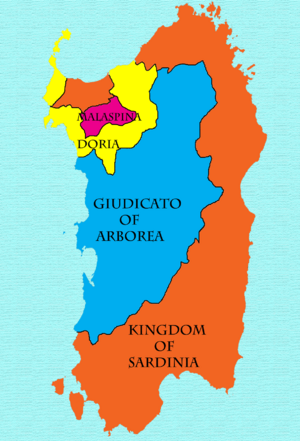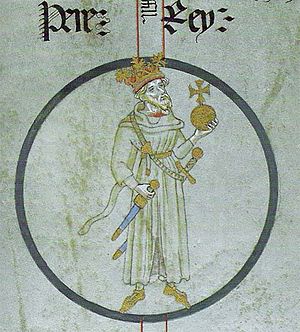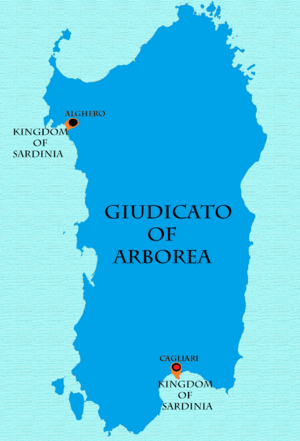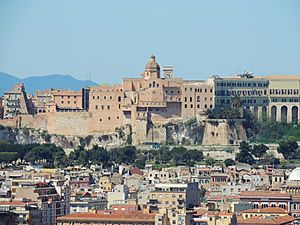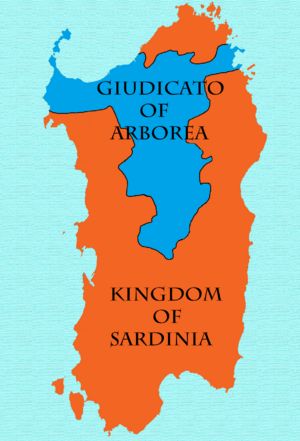Sardinian–Aragonese war facts for kids
Quick facts for kids Sardinian–Catalan war |
|||||||||
|---|---|---|---|---|---|---|---|---|---|
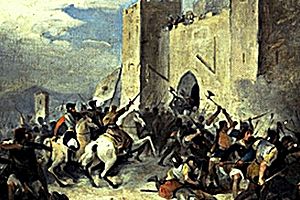 The battle of Sanluri by Giovanni Marghinotti |
|||||||||
|
|||||||||
| Belligerents | |||||||||
The Sardinian–Aragonese War was a long fight that happened a long time ago, from 1353 to 1420. It was all about who would control the island of Sardinia. On one side was the Judicate of Arborea, a powerful local kingdom. They teamed up with the Doria family and the city of Genoa. On the other side was the Kingdom of Sardinia, which was part of the bigger Crown of Aragon (from what is now Spain).
Contents
How the War Started
In 1297, the Pope tried to stop a fight between two powerful families, the Angevins and the Aragonese. They were arguing over the Kingdom of Sicily. To help, Pope Boniface VIII created a new kingdom called Sardinia and Corsica. He gave it to James II the Just, who was the King of Aragon.
In 1323, the Aragonese started to take over Sardinia. A large army sailed from Spain to the island. At that time, different groups controlled parts of Sardinia. These included the cities of Pisa and Genoa, and powerful families like the Doria. The Judicate of Arborea was the only local kingdom still standing.
The ruler of Arborea, Hugh II of Arborea, agreed to become a loyal subject of James II of Aragon. In return, he hoped to rule all of Sardinia for the King. Hugh then started fighting against Pisa. The Aragonese helped him. Pisa was defeated and had to give up their lands in Sardinia. These lands became the first parts of the new Kingdom of Sardinia.
Later, in 1343, more land was added to the Kingdom of Sardinia. This happened when Giovanni Malaspina di Villafranca died without sons. His lands went to Peter IV of Aragon. The Aragonese then fought with the Doria family, who owned large parts of northern Sardinia. In 1347, the Doria family won a big battle against the Aragonese. However, in 1353, a combined fleet from Venice and Aragon defeated the Genoese fleet. Soon after, Aragonese troops took over the Doria city of Alghero.
The Long Conflict Begins
First Battles (1353–1354)
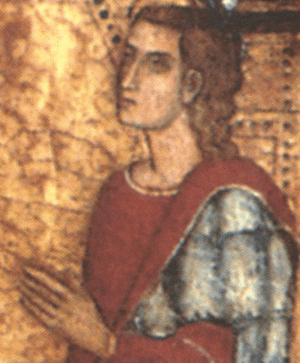
In September 1353, Marianus IV of Arborea, the ruler of Arborea, felt threatened by the Aragonese. They were taking more control of the island. So, Marianus broke his alliance with Aragon and declared war. He teamed up with the Doria family.
Marianus's army moved into the southern part of Sardinia. Many villages joined his side and rebelled against the Aragonese. His army even threatened Cagliari, the capital of the Aragonese Kingdom of Sardinia.
The Aragonese governor in Cagliari asked Admiral Bernat de Cabrera for help. Marianus had cut off supplies to Cagliari. But Cabrera arrived and defeated Marianus's army near Quartu. This helped to relieve the siege on Cagliari.
Meanwhile, in northern Sardinia, the Doria family stirred up more rebellions. In October, the fortress of Monteleone Rocca Doria rebelled. Alghero was also taken back by the Doria. By the end of 1353, Arborea and the Doria family controlled almost all of Sardinia. Only Cagliari, Sassari, and Villa di Chiesa remained in Aragonese hands.
Marianus was a skilled military leader. His kingdom was rich from selling grain. This allowed him to have a strong army. He had foot soldiers, knights, and even crossbowmen. He also hired experienced soldiers from other countries.
King Peter IV of Aragon decided to send a large force to stop the rebellion. He arrived in Sardinia in June 1354, planning to take back Alghero.
The Aragonese tried to capture Alghero for about five months. But it was a disaster for them. Many soldiers got sick with malaria and died. Marianus brought his troops close to Alghero but did not attack directly. To avoid a complete defeat, Peter started talking with Marianus.
On November 13, 1354, they signed the Peace of Alghero. Marianus got many things he wanted. His kingdom remained independent. He could trade freely in his ports. He also gained control of the area of Gallura. The agreement also said that the governor of Sardinia had to be someone Marianus liked. In return, Peter IV could take Alghero. The people living there, who supported Genoa, were moved out. New settlers from Catalonia (part of Spain) moved in.
More Fighting (1365–1388)
The peace did not last long. In 1365, Marianus attacked Aragonese lands again. He captured many villages and castles. He also took the mining town of Villa di Chiesa. In 1366, he built a camp near Selargius to stop supplies from reaching Cagliari. But Cagliari did not surrender. With help from Genoa, Marianus also started fighting in northern Sardinia.
In June 1368, an Aragonese army marched towards Oristano, Arborea's capital. Oristano had never been attacked by the Aragonese before. Hugh, Marianus's son, came to defend the city. Marianus then surprised the Aragonese army and defeated them near Sant'Anna.
In 1369, Marianus captured Sassari and Osilo. By 1370, the Aragonese only held Cagliari, Alghero, and a few castles. In 1374, the Genoese fleet attacked Cagliari's port to help Marianus. But the royal troops fought them off.
Marianus IV died in May 1375, possibly from the plague. He was at the peak of his power. His son, Hugh III of Arborea, took over. Hugh continued his father's plan to expand Arborea. However, he was not as successful as his father. Cagliari and Alghero remained unconquered.
Hugh III's rule was short. Like his ancestor John of Arborea, Hugh III and his daughter were killed in 1383 during a riot. Frederick of Arborea became the next ruler, followed by Marianus V in 1387. Both were sons of Eleonora d'Arborea and Brancaleone Doria. But they were too young to rule. So, their mother Eleonora took charge. In 1388, she signed a peace treaty with Aragon. She promised to give back the lands her family had conquered.
Final Stages (1390–1420)
After a few years, the fighting started again. Brancaleone Doria, Eleonora's husband, was freed by the Aragonese. He said the peace treaty was not valid. On April 1, 1391, he marched towards Cagliari. On August 16, with his son Marianus V of Arborea, he took Sassari and Osilo. By September, he had captured many castles. Only Alghero and Longosardo remained with the Aragonese. He then took Villa di Chiesa and Sanluri. In a letter from 1392, Brancaleone said he had taken back all the lands they owned in 1388.
The Aragonese still controlled the sea around Sardinia. In 1406, Brancaleone attacked again. He invaded many lands in southern and eastern Sardinia. He captured the castle of Quirra and attacked Longosardo. He also tried to capture Cagliari.
Eleonora died in 1404, and Marianus V died in 1407. Brancaleone Doria lost his power and died in 1409. The throne of Arborea was offered to William III of Narbonne. He was a nephew of Eleonora. He became ruler with the name William II. The heir to the Aragonese throne, Martin I of Sicily the Younger, saw this as a chance. On October 6, 1408, he landed in Sardinia with a strong army.
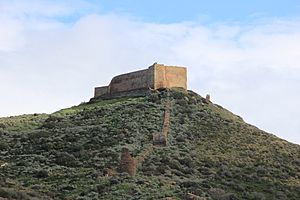
After talks failed, the war continued. The main battle happened on June 30, 1409, near Sanluri. It is called the Battle of Sanluri. The Aragonese army split William's army into two parts. One part was completely destroyed. The other part tried to retreat but was also defeated. On July 4, Villa di Chiesa surrendered.
This was a huge defeat for Arborea. However, Martin the Younger died soon after, on July 25, 1409, from malaria. William II of Narbonne went back to France to get help. He left his cousin, Leonardo Cubello, in charge of Arborea.
Despite the big loss at Sanluri, the Arboreans did not give up. The fighting continued. On August 17, the Arborean army fought off a strong attack on Oristano. The next day, another battle happened. The Aragonese lost many men. The war was not over yet. The Aragonese got more soldiers. The Arboreans fought hard. It took seven months for the Aragonese to capture more castles. In January 1410, the Aragonese took Bosa and attacked Oristano. Finally, Leonardo Cubello signed a surrender agreement. He gave up Oristano and much of the historic Arborea kingdom. He was given the title of Marquis of Oristano. Some parts of Arborea still remained independent.
In the spring of 1410, William II of Narbonne returned from France. He organized the remaining territories. He moved the capital of Arborea to Sassari. With help from Nicolò Doria, he took back a castle and threatened Oristano and Alghero. The war continued. In May 1412, William managed to enter Alghero with his soldiers. But he was forced back by the strong resistance of the people there.
William realized he could not win. He talked with the new King of Aragon, Ferdinand I of Aragon, and later with his son Alfonso V the Magnanimous. They reached an agreement on August 17, 1420. What was left of the old Judicate of Arborea was sold for a large sum of money (100,000 gold florins).
What Happened Next
The years of this war were very difficult for Sardinia. The Judicate of Arborea was destroyed. This meant the end of any hope for Sardinians to rule themselves. Many villages were emptied or disappeared because of the fighting. There were also many outbreaks of the plague. Thousands of Sardinian prisoners were taken to other lands controlled by Aragon, like the Kingdom of Majorca, and forced into slavery.
See also
 In Spanish: Guerra sardo-aragonesa para niños
In Spanish: Guerra sardo-aragonesa para niños


